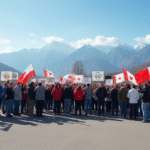Introduction
The prices of various products, ranging from coffee and audio equipment to home furnishings, have surged in June, prompting economists to view this as evidence that the Trump administration’s import tax hikes are being passed on to consumers.
Inflation Rise in June
The Consumer Price Index (CPI) increased by 0.3% in June, translating to an annual rate of approximately 3.5%. This follows a 0.1% increase in May.
Impact of Tariffs on Inflation
Economists and Federal Reserve (Fed) officials anticipate that inflation will gain momentum this summer as the delayed effects of tariffs ripple through businesses. June’s data suggests that policymakers at the central bank may remain hesitant to cut interest rates until more information is available.
While the tariff impact might be a temporary, point-in-time adjustment, uncertainty remains due to Trump’s ongoing consideration of final tariff levels and threats of higher duties starting August 1st.
Notable Price Increases
Omair Sharif, Director of Inflation Insights, stated, “The report shows that tariffs are starting to be felt. Clothing prices rose, home furnishings skyrocketed, and recreational products increased.”
These are mass-imported items, and the price increases have been substantial. Audio and video equipment prices rose by 1.1% during the month and increased by 11.1% annually, marking the largest increase ever recorded in a category where globalization typically resulted in stable or declining prices.
Fed’s Response and Market Impact
The Fed, which has faced daily criticism from Trump for not cutting interest rates, may interpret these price increases as a cautionary signal. Central bankers have shown reluctance to lower rates until the tariff effects on the U.S. economy are clear.
Susan Collins, President of the Fed’s Boston branch, warned in a speech on Tuesday that she still believes import tax hikes could boost inflation while reducing growth and employment. However, she added that the solid balance sheets of both businesses and households could help absorb and mitigate the impact.
The tariff effect might be softened by companies reducing profit margins and consumers continuing to spend despite price increases. Consequently, the adverse impact of tariffs on labor market conditions and economic growth could be more limited, according to Collins.
Trump’s Response and Inflation Claims
Trump took to social media, asserting that consumer prices were “LOW” and reiterated his call for the Fed to cut rates. The June consumer price level was approximately 1.2% higher than in December, the last full month before Trump began his second term.
Karoline Leavitt, White House Press Secretary, stated that the modest basic inflation increase “demonstrates that President Trump is stabilizing inflation.”
Key Questions and Answers
- What is causing the recent inflation surge? The price increases are largely attributed to Trump’s import tariffs, which have been passed on to consumers.
- Which product categories experienced the most significant price hikes? Audio and video equipment, home furnishings, and recreational products saw substantial price increases.
- How is the Federal Reserve responding to these inflation concerns? The Fed remains cautious about cutting interest rates until tariff effects on the U.S. economy are clear.
- What factors might mitigate the impact of tariffs on inflation and economic growth? Companies reducing profit margins and consumers continuing to spend despite price increases could soften the tariff impact.
- What is President Trump’s stance on inflation and the Federal Reserve? Trump claims consumer prices are low and urges the Fed to cut interest rates.






